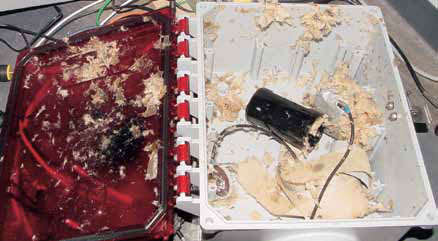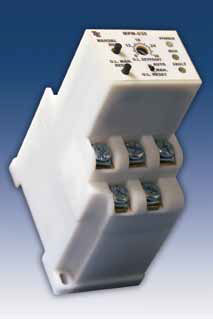New motor starting controller provides one solution.
Pump systems come in all sizes, from large municipal plants to small residential systems using single phase pumps that are three hp or smaller. All systems require reliability, but because of the large volume of smaller systems, the consistent dependability of these stations is extremely important. One of the largest problems facing service personnel in servicing these pumps and controls is the traditional start circuit. Without any real protection on the start winding and start circuit, the start capacitor commonly fails. This often means the capacitor explodes, sending hot oil and capacitor debris into a control panel—or worse and more dangerous, onto a service technician.
The External Start Process
All single phase pumps with external start components use a start relay along with a start capacitor and a run capacitor to start and run the pump. A run capacitor stays in the motor circuit continually, while the start capacitor is designed to be removed from the circuit once the pump motor is up to speed. The purpose of the start capacitor is to cause the voltage applied to the start winding to be out of phase with the voltage coming from the power source. This phase change gives the motor increased torque when starting. The start relay's job is to remove the start capacitor from the circuit when the motor gets up to speed. Traditionally, this is accomplished by using a potential relay as the start relay. As the motor increases in speed, the voltage potential across the start winding increases. Once the voltage potential reaches a predetermined value, the start relay will energize, opening the circuit to the start capacitor. Under normal operation, the start capacitor will be removed from the circuit less than a second after power has been applied to the motor.
The start capacitor has a lower voltage rating than the voltage that will be applied to it from the start winding. In most instances, this is because the capacitor is expected to be in the circuit for a short period of time, and a capacitor that is rated for the full voltage would cost more money and require more space. If the start capacitor does not get removed from the circuit, the capacitor will fail because of the lower voltage rating. Often, this results in the top exploding off the capacitor spraying hot oil (300 deg F and hotter) and projectiles and exposing dangerous electrical voltages. Several situations may cause the start circuit not to open. One of the most common is a locked rotor on the pump. In this case, the pump is plugged or jammed from debris, and the motor cannot rotate. If the pump cannot rotate, it will not build up the voltage on the start winding needed to drop out the start capacitor, which will create the conditions that allow the capacitor to fail.

Failed Starter Capacitor
Motor Module Replaces Starter and Start Relay
A motor power module (MPM) will soon to be available to replace the motor starter (contactor and overload) and the start relay, all in one compact unit. One of the most significant features of the MPM is that it protects the start capacitor by monitoring its usage. If its usage is excessive, the MPM will disable the capacitor for a period of time, allowing for cool-down time. Cool-down typically takes a few minutes, and then the capacitor is available for use again as needed.

Motor Power Module
In applications using single phase grinder pumps, the MPM improves the pump performance in another way. During normal operation, the pump often sucks debris through the cutters of the pump, introducing an added load to the pump motor. Depending on the type of debris and the condition of the cutters on the pump, this load can be significant and slow the pump. A traditional start circuit with a potential relay allows the pump speed and flow to drop below 40 percent of its normal operating speed/flow before pulling in the start circuit to provide the added
torque needed to prevent the pump from stalling during the grind. This reduction in speed compounds the problem of grinding and expelling the debris as the water flow through the pump is greatly reduced. The MPM begins “boosting” the pump by pulling in the start circuit when the pump speed and flow reach 85 percent of normal. The MPM controls just how much boost is given to the start circuit, providing only the amount of boost needed to maintain speed, maximizing the amount of usage available for the start capacitor.
Another advantage of using the MPM is that it reduces the complexity of matching proper start components with motors. With traditional systems, every pump motor on the market has its own combination of start relay, start capacitor and run capacitor. Applying the wrong component combination can cause start capacitor failure. The MPM monitors the characteristics of the motor as it starts and removes the start capacitor at the proper time based on those characteristics. One MPM can be used for any pump within the MPM's rated current range. Even if the wrong start capacitor is chosen, the MPM is designed to protect against failure. The motor torque will be affected by the wrong capacitance, but relatively normal pump operation may still be possible depending on the pump motor and the value of the capacitance.
All in One
The MPM combines the functions of the motor contactor, overload relay and start relay in one compact unit, which is approximately the size of a comparable standard motor contactor. This combined unit saves at least 60 percent of the panel space taken up by a traditional start circuit. One of the ways the MPM is able to provide this kind of space reduction is by using patented zero-cross technology. This technology controls the exact timing of the opening and closing of the contacts that supply the power to the motor. Without zero-cross technology, the contacts would open randomly compared to the AC voltage waveform, often causing arcing across the contacts. This normally requires larger contacts, and a larger contactor to handle the motor power. With zero-cross technology, the arcing is almost eliminated, which increases the life and reliability of the relay, while allowing the use of a smaller contactor to control the pump.
In addition to zero-cross technology, the MPM includes advanced motor protection and monitoring, and implements a Class 10 electronic overload while monitoring for under-current to protect the pump from a “run dry” situation. The MPM monitors incoming voltage and can be set to protect against a low-voltage situation either from the power line, or because too small a wire gauge was used to supply the power to the pump (causing too much voltage drop in the source feed wires).
This approach, using new technology in pump controls, will continue to enhance safety, reliability and serviceability. The MPM will reduce the common occurrence of start component failures to something that is rarely considered. This reduction not only improves safety, but reduces down time by increasing the reliability of the pump installation.
Pumps & Systems, October 2010


